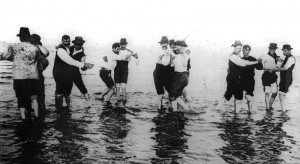There is minimal accurate or written history of the origins of this dance since it was a creation of a poor and uneducated class of people marginalized in the explosive environment of Buenos Aires. It was a dance of the people. Interesting factors converged in Argentina to create this dance:
- In the 1830’s, the Viennese Waltz craze swept Europe with couples actually holding each other. The Polka, in the 1840’s was the second dance with couples holding each other, and it was also quite the fashion.
- There was likely a quasi-martial art practice by the gauchos out on the pampas. Knife fights were common in country and city. Tango stepping style would be useful for a knife fighter.
- Argentina banned slavery in 1853 so slaves and free blacks had reason to dance. They may also have coined the word tango as a place where people dance.
- In 1857, the first piece of music was published that identified itself as tango. It probably referred to Tango Andaluz, a style of music from Andalucia, Spain, the birthplace of flamenco.
- From the mid-1800’s, there was massive migration from Europe to Argentina to make a better life. Men came from Italy, Spain, Britain, Germany, Poland, France, Turkey, Ireland, Russia, and they danced from loneliness for the families that they had left behind and to impress the women who were in scarce supply.
- They danced the local dances and made a dance of their own from candombe, vals criollo, habanera, flamenco, polka, milonga (different from the milonga we know today), mazurka and ballroom . European immigrants with their instruments were being influenced heavily by Latin American and African music.
- The population of Buenos Aires in 1869 was 180,000 and would soar to 1.5 million by 1914.
- Street musicians were common; they played tango music, and men danced with men to get better.
- In 1886, the bandoneón (the instrument with a soul) migrated to Argentina from Germany.
As in New Orleans, the brothel owners hired musicians to play while the men waited for their turn with a Lady of Negotiable Affection although there was little time to dance with them. The men danced with each other. Two critical things came out of this: the upper classes went slumming and were exposed to tango dancing and smoothed some of the rougher edges from the dance as they slowly introduced the dance back into more respectable society and the Argentine Tango was about to leave Argentina. [More to come]
In the picture: Hombres bailando tango en el río, 1904 – Archivo General de la Nación Argentina
Patrick Ashby, student of Dance with me Toronto

